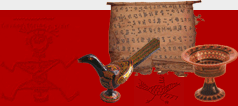|
喜玛拉雅─藏彝走廊区域送魂指路文化研究——以纳西族《指路经》与彝族《指路经》比较研究为例
The Rituals of Sending off Souls and Showing the Road among
the Peoples of the Himalayas and the Zang-Yi Corridor: Using
the Comparative Example of the "Road Guide Scriptures"
of the Naxi and Yi
木仕华 Mu Shihua
中国社会科学院民族学与人类学研究所
【摘要】送魂现象与《指路经》及送魂迎神路线是印度、尼泊尔、中国喜玛拉雅区域及中国藏彝走廊藏缅语诸民族中的一个共有的文化现象,尤其在彝缅语集团的诸族群宗教文化中十分突出。非藏缅语族群中,据目前所知仅在贵州苗族中有此现象。日本学者宫本神酒男多年的跨国田野调查表明中国彝族、纳西族、黍兴藏族、呷咪藏族、白族(那玛人)、怒族、普米族、傈僳族、傈僳族、拉祜族、景颇族、哈尼族;尼泊尔的灵布族、尔挨族、马戈尔族、考沙族、念巴族;印度尼泊尔边境上的姜斯族;印度西北部的金弄尔族中都普遍有送魂指路文化。而在这些民族中仅彝族和纳西族有本民族文字和悠久的文献传统,故其传统宗教经典中有专门的《指路经》。其他民族大都以口诵经的形式传承。对许多民族而言,送魂路线、迎神接祖路线是同一个过程的两个逆向关系。有的民族有送魂路线,却没有迎神路线;相反,也有的民族有迎神路线,却没有送魂路线,使共有的送魂指路文化下派生出许多的次生类型,形成了既有统一共性特征,又有多元个性的喜玛拉雅─藏彝走廊区域送魂指路文化。送魂路线、迎神路线关乎各民族的祖源地、迁徙路线及族群间的历史关系,尤其是宗教观念的传播以及对喜玛拉雅-藏彝走廊区域的藏传佛教、苯教、东巴教、韩规教、毕摩教、贝玛教等多民族宗教文化研究而言至关重要。故我们以有文字文献传统的纳西族和彝族的《指路经》为例作比较研究,以期有助于深化喜玛拉雅-藏彝走廊区域的送魂指路文化的研究。
关键词: 纳西 彝 指路经
Abstract
The Road Guide Ritual and its accompanying “Road Guide
Scriptures” are a religious phenomenon common to the Himalayan
Area and the Tibetan-Yi Corridor. In the funeral ritual,
priests send the soul of the dead to Kyunglung (Chunglung)
Gui Bhat (Nine valleys of Kyunglung) or another sacred place
in historical memory. When someone dies, the priest will
narrate myths and guide the soul to the ancestral world
village by village like a travel itinerary route. This kind
of soul sending ceremony exists among other ethnic groups
too, such as the Gurung, Thakali, Tamang, Rai and Limbu
in Nepal, the Kinauri in India and the Chan, Naxi, Pumi,
Nami, Lisu, Lahu and Yi in China. For example, the Thakali
and Gurung, have a soul sending ritual in which their priests
send souls to Lake Manasarovar. After the lake, it is not
possible to identify the name of the soul’s desitnation
as a real geographical location. Nyimba priests also call
the soul or spirit from Kyunglung. We need to research soul
calling rituals also, as Japanese scholar Miyamoto reported
in 2003. Other common factors include Naga (klu) and Garuda
(khyung) worship. Comparative studies of this paper focus
on road guide manuscript between Naxi and Yi ethnic group
in China. It’s aim is to reveal the relationship of Naxi
and Yi, especially focusing on religion and migration history,
and to reconstruct the proto-type of their culture in ancient
times.
Keywords: Naxi─Yi─"Road Guide Scriptures"
作者简介:
木仕华,男,纳西族,云南丽江人,毕业于中国社会科学院研究生院,获博士学位,现为中国社会科学院民族学与人类学研究所副研究员。主要致力于纳西族文化研究及藏彝走廊诸族群的社会文化人类学研究。主要著作有《卡卓语研究》《天路灵光——三江并流文化经纬》《东巴教与纳西文化》《纳西东巴文字的文化阐释》,主要论文有《论古摩挲的分化与中国纳人的认同问题》、《纳西东巴文与藏文的关系》、《纳西东巴文中的卐字》《丽江木氏土司与藏传佛教诸派关系考论》、《纳西东巴经典中的梵语借词研究》《纳西东巴文化研究国际化综论》等。
About the Author:
Mu Shihua is a native Naxi, born in Lijiang, Yunnan Province,
received his Ph. D. in Ethnology from the Graduate School
of Chinese Academy of Social Sciences. He is an associate
researcher at Institute of Ethnology & Anthropology,
Chinese Academy of Social Sciences. His main works are :
1) Studies on the Language of Mongols in Tonghai County
Yunnan Province, Ethnic Publishing House, Beijing 2003.
2) An Outline of Ethnic Culture in Tri-River area in Southwest
China, Yunnan Ethnic Publishing House, Kunming 2004; 3)
Dto-mba Religion and Naxi Culture, Press of Central University
for Nationalities, Beijing 2004; 4) Cultural Interpretation
of Naxi Pictography, Heilongjiang Publishing House , Ha’erbin
2005. He has published dozens of papers and articles.
|





